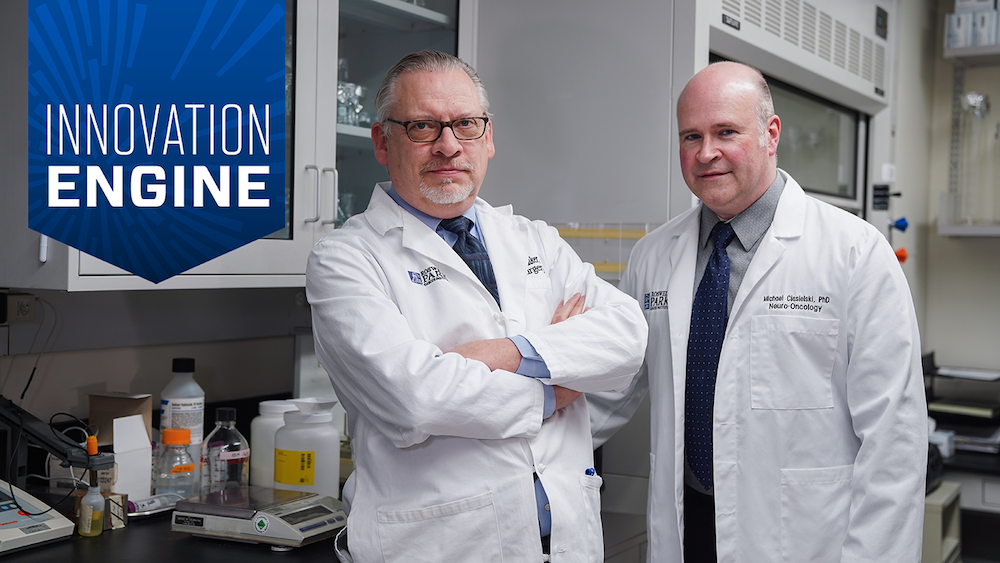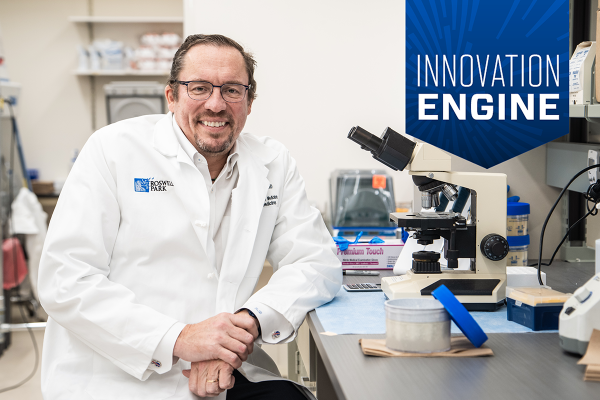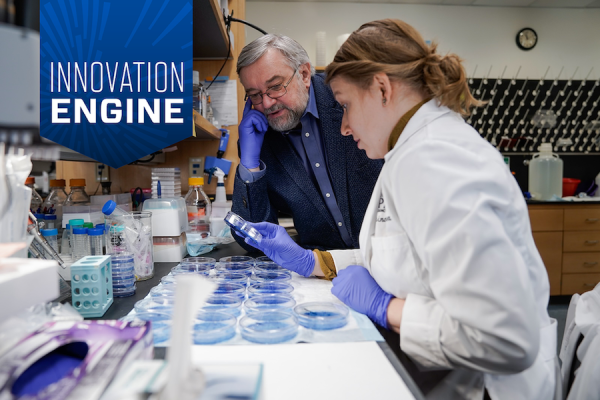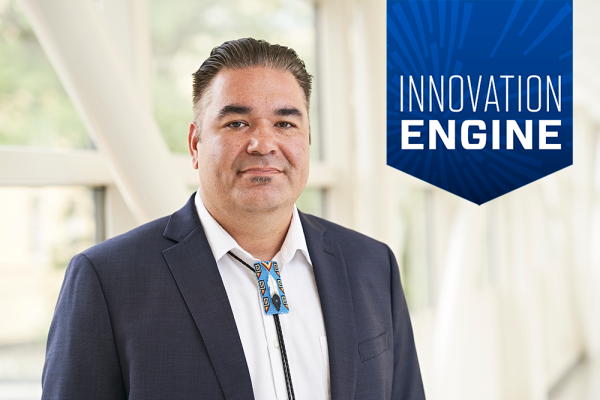The Innovation Engine series highlights high-impact Roswell Park science that advances the priorities of the National Cancer Plan — a roadmap for working together to end cancer as we know it. The work outlined in this post supports Goal #3: Develop Effective Treatments.
Robert Fenstermaker, MD, was just a boy when two of his young cousins — a brother and sister — died of malignant brain tumors. The loss led him to wonder about the nature of those tumors, and in the search for answers, he became a neurosurgeon.
But he has always been aware that when it comes to the most aggressive brain tumors, including glioblastoma — the deadliest of more than 100 types — even complete removal won’t result in a cure. Malignant cells, each ten-millionths of an inch wide, will always escape the scalpel. Those tumors always return.
Instead, Dr. Fenstermaker began to approach the problem from a different angle: With a little help, could the patient’s own immune system destroy the tumor? As Chair of the Department of Neurosurgery and Director of the Neuro-Oncology Program at Roswell Park Comprehensive Cancer Center, he teamed up with Michael Ciesielski, PhD, Assistant Professor of Neurosurgery and Director of the Neuro-Oncology Lab, to develop a promising brain cancer vaccine called SurVaxM. Originally designed to attack glioblastoma, it has been evaluated in clinical trials and found to double survival time in adults, from an average of 14 months after diagnosis to 28-30 months.
“Nine of the originally enrolled patients are still alive, six to eight years after diagnosis, and five have never had a tumor recurrence,” says Dr. Ciesielski. Based on the results of those first clinical trials, the FDA is helping speed the way through its drug-approval process by granting the vaccine “orphan status” for all forms of adult and pediatric gliomas — a broader category of brain tumor that includes glioblastoma.
How does the SurVaxM vaccine work?
It triggers the immune system to shut down survivin, a protein that many tumor cells, including glioblastomas, need to survive. Most patients first undergo surgery to remove the tumor and then receive an injection of the vaccine — in the arm, just like a flu shot — four times over six weeks, and then once every three months as long as it continues to be effective.
Blood tests performed on the first clinical trial participants showed that the immune system reacts to the vaccine just as Drs. Fenstermaker and Ciesielski hoped. Patients develop immune cells called T lymphocytes, or T cells, that multiply and kill tumor cells that produce survivin. Because survivin is not typically found on healthy cells, they’re protected from the treatment, so side effects tend to be mild, from pain or itching at the injection site to fatigue and muscle aches in some patients.
There’s even more good news: Because survivin is produced by many other types of tumors, the vaccine could be effective in other cancers as well. With support from the Roswell Park Alliance Foundation, which supported this research from the very beginning, a clinical trial for multiple myeloma patients has just concluded at Roswell Park, and another for neuroendocrine tumors is underway.
The Roswell Difference
Pioneering innovation like this is part of what makes Roswell Park an "Exceptional" comprehensive cancer center, designated by the National Cancer Institute.
Studying the vaccine in younger patients
Until now, SurVaxM has been tested in adults only. But every year, more than 4,000 children and teens in the U.S. develop brain and spinal cord tumors, which are second only to leukemia as the most common childhood cancers. Can the same vaccine work for younger patients?
In the first step toward finding out, Clare Twist, MD, Director of Pediatric Developmental Therapeutics and the Katie Dougherty Endowed Chair in Pediatric Oncology at Roswell Park, is leading a pilot clinical trial through the Pediatric Brain Tumor Consortium, which is supported by the National Cancer Institute. At Roswell Park and 11 other centers across the nation, the study expects to recruit 30 patients ages 1-21 years who have one of eight different types of brain tumors, including glioblastoma. “These are the highest-risk pediatric brain tumors, including one for which there is no established curative therapy — diffuse intrinsic pontine glioma (DIPG),” says Dr. Twist.
“The patients in this clinical trial are different from those in the adult clinical trials, because the pediatric patients will have more disease at the time of SurVaxM treatment. In the adult phase 2 trial, the patients were treated right after their initial surgery, so they had little disease left and received the vaccine along with standard chemotherapy. “In the pediatric patients, the clinical trial is designed for patients whose disease has come back after they have received standard-of-care therapy — usually chemotherapy and radiation — and the disease is not responding to further treatment. They’re in a higher-risk group compared with adults.” She adds that as a phase 1 trial, it’s focused primarily on evaluating safety.
Looking ahead toward the next breakthrough
This marks the beginning of what promises to be an epic journey, and Dr. Twist is hopeful. “We’re just starting to understand how to optimize immunotherapy, particularly for pediatric cancers,” she says. “But when we get a hint that antibody therapy improves outcomes, as it does in neuroblastoma — and we’ve shown that in clinical trials over and over again — that tells us that we can harness the immune system in children with a very high-risk malignancy. If we can do it in neuroblastoma, we should be able to do it in other cancers.”
As she and her fellow investigators move SurVaxM in this new direction, they’re already thinking ahead. “Lots of malignancies produce survivin to one degree or another, but it hasn’t been studied as much in pediatric tumors,” she says. “Dr. Ciesielski and I are working with other researchers at Roswell Park, thinking about what sorts of preclinical experiments we need to do to demonstrate that survivin is produced in pediatric and young-adult tumors such as neuroblastoma and sarcoma. Then we can design a clinical trial, hopefully in the near future, for cases where the tumor comes back and we sometimes struggle to find new, effective therapies. “SurVaxM might become one more tool in our toolbox.”




